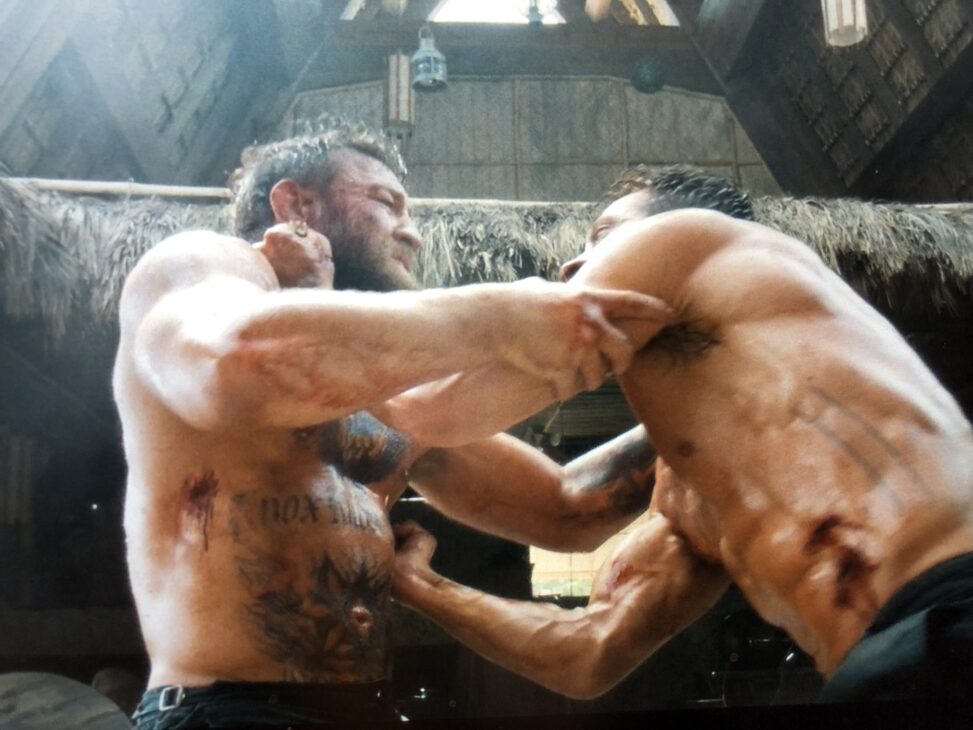The most recent action film I watched was “Roadhouse”, featuring Jake Gyllenhaal and former UFC Champion Conor McGregor. The screengrab depicts the climax of the action of the film, where Gyllenhaal’s character Dalton brutally kills McGregor’s Knox with the jagged edges of broken tables and chairs. The main focus of the scene is all in one take, an unbreaking cut that does not stop until Knox falls to the ground as he succumbs to the multiple stab wounds. This scene does differ from previous ones however, whereas the action sequences before were fast paced and featured many quick cuts to portray the frantic nature of the many brawls, this scene takes a different approach, using one single take to portray how this is the end of the action all together. There is a lot of violence in this movie, this scene in particular features Dalton with a swollen eye along with various other bruises and cuts for both participants. Mainly however, is the multiple gruesome stab wounds Knox displays on his upper body. Before the climax of the scene, there were many camera cuts, again signifying how frantic and tense the action is. Steven Schwan gives an interesting take on camera cuts in his submission to the “Memory and Cognition” article, he describes it as a “unitizing the continuous flow of events”. Our point of view is right in the action, making the audience believe they themselves are right in the action, we switch back and forth between the characters at a rapid, frantic pace. We do not necessarily “follow” a certain character, despite Dalton being the main character, we do not see the action from his point of view. We get a neutral point of view that allows us to see every little detail of the fight. The camera movement makes you fully aware of its presence, the breakneck pace exemplifies the extreme action going on. In a minute long sequence, it depends on the tone of the scene to determine how many cuts there are. In the final scene I was able to identify around ten cuts within the first few seconds, I ended up losing count trying to keep up with the action on screen. The edits are very noticeable, like previously mentioned, the action sequences are quick and frantic with many cuts to convey that. Though there are a handful of one take scenes, where author Lucy Fisher describes perfectly by explaining “coherent sequence and flowing continuity” in “A Companion to Film Editing”. Roadhouse was released direct to Amazon Prime, as of now the film’s earnings have not been made public. As over the top and, for lack of a better term, cheesy, the film features a handful of real life consequences that can arise from it. The film could give viewers the idea of going out to their local bar or club and picking fights with anyone, which can lead to injuries or even worse. The film could give viewers the impression to try the various mixed martial arts moves on friends and or family, which again could lead to injury.
Bibliography
Schwan, S., Garsoffky, B., & Hesse, F. W. (2016, May 3). Do film cuts facilitate the perceptual and Cognitive Organization of Activitiy Sequences? – Memory & Cognition. SpringerLink. https://link.springer.com/article/10.3758/BF03213801
Google. (n.d.-b). A companion to film theory. Google Books. https://books.google.ca/books?hl=en&lr=&id=WFzKOKz9X-0C&oi=fnd&pg=PA64&dq=film%2Bediting&ots=4wHZGkdG1x&sig=Bmp9dwEGImfP2btI9fuH2r9g0_4&redir_esc=y#v=onepage&q=film%20editing&f=false


Lara VanWoerden
I have never seen the film Roadhouse, however, I can get a pretty good idea of what the movie is about and what the action scenes are like from the description that Peyton shared. The mise en scene description of the scene in the screen grab gives me a good idea of what the movie looks like and what the movement through the scenes feel like if I were to watch it.
I agree with Peyton’s assessment on how the scenes worked and how they moved, for example, I agree that the way that the scene cuts/edits created frantic and intense scenes. I do find it interesting though, that the scene in the screen grab is filmed all in one shot, I think that, if done well, this could make it this scene feel very intense and feel like we as the audience are involved in the action, just as Peyton pointed out.
Yes, they have used their experience broaden and include the discussion of scholarly research. Their sources touch and expand on the use of shooting different angles for scenes, of which they talked about in their assessment. However, I would not say that they are the best sources, since they don’t really delve deep into other aspects of this assignment such as gender, race, and roles in the film.
Their image is a pretty good illustration of their description since they took the screen grab from an action scene at the peak of the action. I can see some of the violence that was inflicted and is about to be landed on the two people in the image.